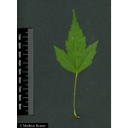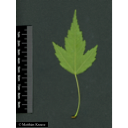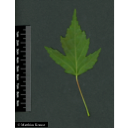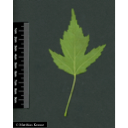Useful information about the taxon (species, subspecies, variety...)
Acer tataricum subsp. ginnala (Maxim.) Wesm. 1890
Sapindaceae
(APG IV)Amur maple
Taxon concept: The Plant List (2010)
Distribution: East Siberia, Mongolia, China, Manchuria, Korea, Japan
Flowering period: V
Acer tataricum subsp. ginnala (Maxim.) Wesm. - Accepted: Acer tataricum subsp. ginnala (Maxim.) Wesm. bei Zander 2008; Familie: Aceraceae (Zander 2008)Acer tataricum subsp. ginnala (Maxim.) Wesm. - Accepted: Acer tataricum subsp. ginnala (Maxim.) Wesm. bei The Plant List (2010); Familie: Sapindaceae (APG III)Acer tataricum subsp. ginnala (Maxim.) Wesm. - Accepted: Acer tataricum subsp. ginnala (Maxim.) Wesm. bei The Plant List (2014), version 1.1; Familie: Sapindaceae (APG III)Acer tataricum subsp. ginnala (Maxim.) Wesm. - Accepted: Acer tataricum subsp. ginnala (Maxim.) Wesm. bei The Plant List (2014), version 1.1; Familie: Sapindaceae (APG IV)
- Leaves
- lamina 3-lobed
- Foliage persistence
- deciduous
Erhardt, W., Götz, E., Bödeker, N. & Seybold, S. (2008): Der große Zander. Enzyklopädie der Pflanzennamen. Band 2. Arten und Sorten. Eugen Ulmer KG, Stuttgart (Hohenheim), 18. Aufl., 2103 S.; Kew Gardens and Collaborators (2017): Plants of the World Online. see: plantsoftheworldonline.org.; Oaks of the World (Accessed: 2019): Quercus glandulifera. See: http://oaks.of.the.world.free.fr/quercus_glandulifera.htm; Plants for a Future (1996-2012): PFAF. See: https://pfaf.org/;
Diese Webseite verwendet Google Maps, um Karten und Standorte von Pflanzen in den Hohenheimer Gärten anzuzeigen. Dadurch werden unter Umständen Daten an Google weitergeleitet, was mit einer Verarbeitung Ihrer personenbezogenen Daten verbunden sein kann. Die Datenschutzerklärung von Google finden Sie hier: Datenschutzerklärung von Google
| Sex | Standort | Accession number | Planting year | Donation | IPEN | Lat. | Long. |
|---|---|---|---|---|---|---|---|
| Parzelle P | EG-P-020-13905 | 1950 | XX-0-HOH-EG-P-020-13905 | 48,7072502083 | 9,209592592 |




